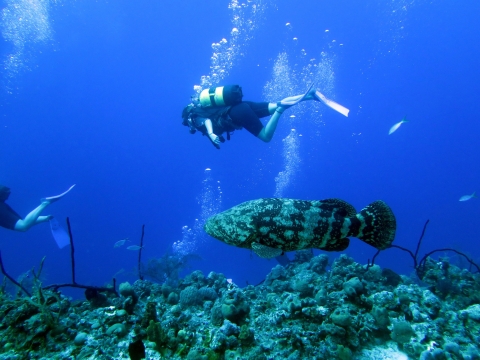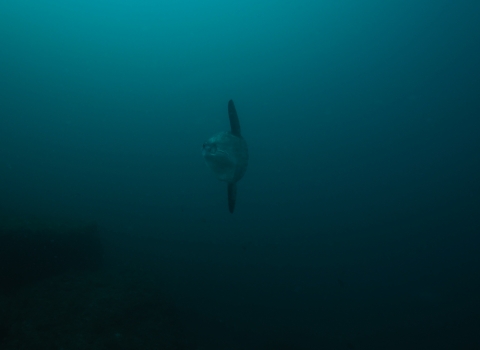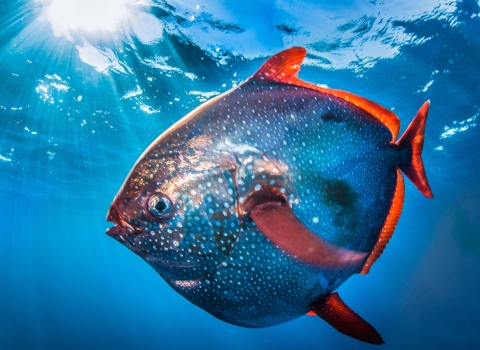Growing up as a rookie fish nerd, aquariums were naturally one of my favorite places to visit with friends and family. Living in southwest Florida meant that those aquarium trips tended to culminate in a lengthy stop by the coup de grace, a massive tank meant to imitate a reef deep within the Gulf of Mexico. Although the gorgeous selection of snappers, jacks, sharks, rays, or grunts was different at each aquarium, there was one familiar giant I could reliably expect. While the speckled black spots, ultra-wide rounded tail, and cavernous mouth are unmistakable, the immense size that gave this fish its name was always what first grabbed my attention. “Goliath” is truly one of the few words that captures the sheer scale of one of our ocean’s largest bony fish: Epinephelus itajara, the Atlantic Goliath Grouper.
But just how big are we talking here? Well, the Goliath Grouper is one of a select few fishes that can be compared to small cars with only mild exaggeration. With peak sizes topping eight feet in length and 800 pounds, they’re unmatched in size by any other grouper in the Atlantic. Despite this, they’re still only the second-largest grouper species in the world, barely edged out in the western Pacific by the aptly named Giant Grouper (Epinephelus lanceolatus). Of course, if you’re a crab or stingray caught without cover on the ocean floor, it’s cold comfort to know that the gaping maw sucking you in only belongs to the silver medal holder for “Biggest Grouper”! Despite the Goliath’s prodigious size, this bottom-feeding heavyweight presents no danger to humans, or even many of the nimble fish species they share the reefs with. In fact, studies have shown that smaller invertebrates like calico crabs make up the majority of their diet.
While juvenile Goliaths fall victim to predation from common piscivores such as Barracuda, King Mackerel, Snook, or various sharks, large adults have no natural predators save for the occasional extra-large Hammerhead or Tiger Shark. These deep-bodied fish sport small black dots all over their body, as well as their huge rounded caudal and pec fins. The signature five dark vertical bands breaking up their yellow-brown coloration are especially distinct on juveniles, allowing them to be easily distinguished from the numerous smaller grouper species (such as gag, black, and red groupers) often targeted by anglers.
These extra-large top predators make their home on all sorts of bottom structure such as rock jetties, bridges, piers, artificial and natural reefs, rocky ledges, and overhangs. They tend to prefer high-relief structure in shallower depths out to about 150 feet, though they are occasionally found deeper. Aggregations of over 100 goliaths spawn around consistent sites such as patch reefs and ledges during late summer, from July to September. Seeing these groups of ultra large spawners have been compared to coming upon “a parking lot of Volkswagen Beetles”.
The resulting eggs and larvae drift inshore, allowing the juvenile fish to hatch and spend their first 5-6 years growing up in various estuaries and mangrove habitats. The Ten Thousand Islands region of the Everglades in southwest Florida has a particularly high abundance of these juveniles. Seeing as even a baby Goliath can top 40 pounds, light-tackle anglers in the region often feel the huge power of these fish on the end of their lines while targeting mainstay Florida sport fish such as Tarpon or Snook. While the federal ban on harvesting Goliaths means that age data is limited, adults are estimated to live about 30 years on average.
While Goliaths were historically found in tropical and subtropical waters along the east coast of the US, their range within the country is now found almost entirely within Florida’s Gulf and Atlantic waters. Populations are also found throughout the Caribbean, Central America, and South America all the way to Brazil. Pacific waters from southern Mexico down to Peru are home to the Pacific Goliath Grouper (Epinephelus quinquefasciatus), the near-identical closest relatives of the Atlantic Goliaths found in the US! The Goliath Grouper’s large size, slow movement, and huge spawning aggregations make them extremely susceptible to overfishing. The destruction of critical mangrove nursery habitat hurts the recruitment of larval Goliaths, compounding the danger posed by overfishing. Unfortunately, we learned these lessons too late—Goliath Grouper were hunted to critically low population levels in US waters, leading to a total moratorium on US fishing enacted in 1990. As of 2023, a highly restricted recreational fishery allows for 200 juvenile Goliaths per year to be harvested in Florida. While populations have bounced back and goliaths are once again a common sight on Florida reefs, overall abundance is still a far cry from its historical peak.
Perfectly at home as demersal ambush predators, Goliath Grouper use their gargantuan mouths to great effect via suction feeding. By quickly opening its jaws and expanding the mouth cavity, a feeding grouper creates a strong suction force as water rushes in to fill the space—carrying with it any unlucky critters in the immediate area. Like all groupers, Goliaths aren’t great endurance athletes, preferring to use their broad fins and deep bodies for powerful and quick bursts of speed to surprise prey or retreat to shelter. That same explosive power (along with meaty and firm white fillets) has made groupers of all types a favorite target of reef anglers worldwide—when your bait or lure gets thumped, get ready for a short but shockingly violent tussle as you strain against the rod to lift the grouper away from its line-shredding rocky home. Even a 10-pound specimen can put up a brutal fight, to say nothing of a grouper weighing in the triple digits!
Now, cards on the table here: I’m mostly talking about Goliaths in the context of how I’ve interacted with and learned about them growing up in Florida. Even without the rose-tinted glasses of my childhood memories, the Goliath Grouper is a fish that has played a huge part in shaping my interest in ocean life; be it in the lab with a respirometer, or 50 miles offshore with a heavy rod in my hands. That’s hardly something unique to me. If you fish, dive, or snorkel around the many offshore wrecks and reefs in Florida, chances are you’ve got some strong feelings about Goliath Grouper. Many divers and snorkelers view Goliaths as majestic, gentle giants, and their undeniable appeal is a huge reason why so many people love to dive in Florida. There’s just something so cool about swimming around a gorgeous reef and getting face-to-face with a peaceful behemoth of a fish that might weigh four times as much as you!
On the other hand, if you’re bottom fishing for snappers, other groupers, and amberjack offshore (one of my greatest passions in life), a hungry Goliath Grouper can make its presence known in a big and often frustrating way. Smaller fishes like the popular Mangrove or Yellowtail Snappers make a big commotion in the water when hooked, and their hampered movement makes them easy prey for any watchful Goliaths living on the same piece of bottom structure. Even an average-sized 300-pound Goliath makes for an unwinnable fight on the lighter rods and reels used for most bottom fishing, leading to snapped lines, straightened hooks, and broken hearts—I’m roughly 0 for 100 with Goliath hookups, having stopped counting a long time ago! Any seasoned snapper angler in Florida knows that hooking a smaller fish over a wreck can be like starting the clock on a ticking time bomb. You’d better tighten that drag and put on as much pressure as possible to haul your quarry boatside or be prepared to witness a massive brown submarine swim up and suck your catch down its gullet.
Though there’s certainly some interest in catch-and-release fishing with the stoutest tackle imaginable, or a rope handline if you’re feeling primitive, many anglers in Florida waters can understandably have some negative opinions on Goliath Grouper. There can be times on certain reefs where it feels like it’s impossible to hook anything without paying the big brown piscivorous tax man! This has led to a widespread belief that Goliath Grouper are overpopulated, infesting the reefs and hoovering up all the smaller fish species with brutal efficiency. Let’s get some clarity, though—this could not be further from the truth. As confirmed by a multitude of diet studies, the vast bulk of a Goliath Grouper’s diet is composed of slow-moving bottom dwellers, not the agile fish species like snappers that tend to live a bit higher in the water column. Crabs, lobsters, shrimps, octopuses, and benthic fishes like stingrays or parrotfishes are some of their mainstay prey items. However, Goliaths are opportunists—if a fish they wouldn’t normally pursue is making a commotion in the water, far from cover and hindered by a hook and line in its mouth, then that’s an easy meal in the making. This type of feeding behavior (known as depredation) is extremely overrepresented when anglers are present in the same area as Goliath Grouper, which can understandably skew perceptions and paint a false picture of how these fish normally feed.
The Goliath Grouper is an iconic fish that inspires and fascinates fish fans of all ages, though it’s also become embroiled in some serious controversy. When discussing the full range of strong opinions people may have regarding these tropical titans, it’s important to recognize how the presence of humans can fundamentally alter the behavior of predatory megafauna like Goliath Grouper. When considering their abundance, it’s also worth remembering just how far from a historic “normal” many of our ocean ecosystems currently are. While the inconvenience they can pose to some anglers is well-documented, so is their role as a charismatic and critical top predator on the reefs of Florida and beyond. Whether in an aquarium tank or out in the wild, the sight of a Goliath Grouper reigning over its patch of reef is something that’s inspired a love of fish and the ocean in people who might not otherwise appreciate fish. I can certainly attest to that fact. So, whether you’re geared up with your camera at the aquarium, a mask and fins below the surface, or a heavy-duty rod and reel with a locked-down drag, let’s give the Goliath Grouper its due respect while celebrating #AllTheFish!
Tune in every Monday for a new episode of Fish of the Week!









